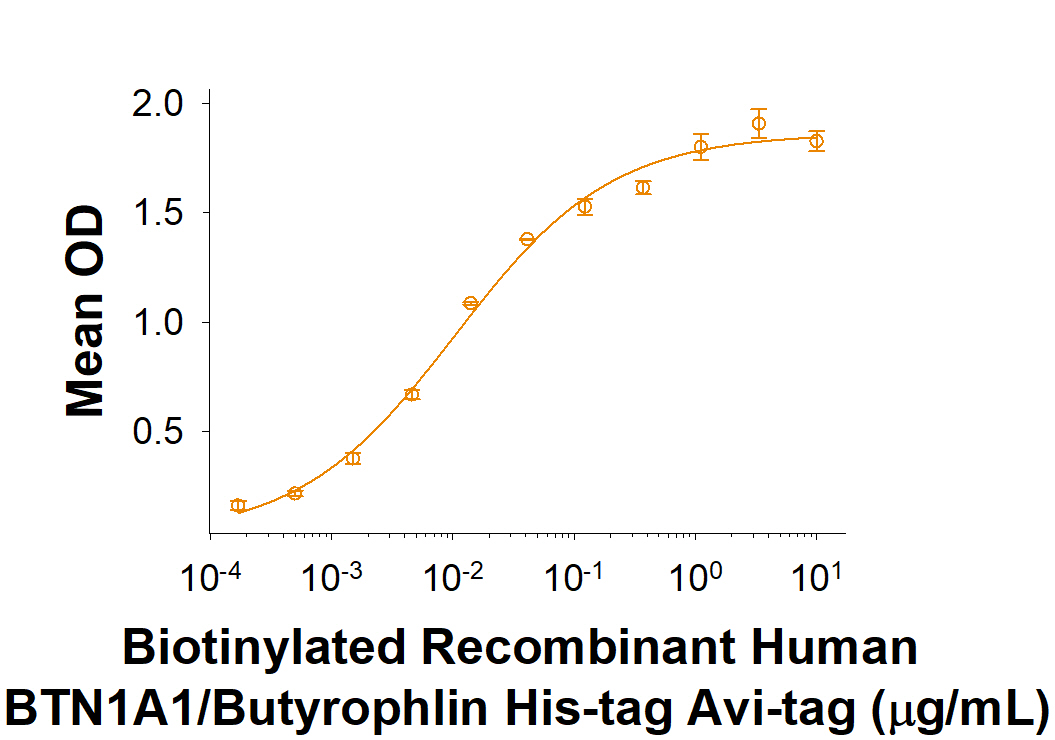Recombinant Human BTN1A1/Butyrophilin His Avi Protein, CF
Recombinant Human BTN1A1/Butyrophilin His Avi Protein, CF Summary
Learn more about Avi-tag Biotinylated ProteinsProduct Specifications
Measured by its binding ability in a functional ELISA. When Rabbit Anti-Human BTN1A1/Butyrophilin Monoclonal Antibody (Catalog # MAB84671) is immobilized at 10 μg/mL (100 μL/well), the concentration of Biotinylated Recombinant Human BTN1A1/Butyrophilin His-tag Avi-tag (Catalog # AVI8467) that produces 50% of the optimal binding response is 0.01-0.1 μg/mL.
| Human BTN1A1/Butyrophilin (Ala27-Arg242) Accession # Q13410 | HHHHHH | Avi-tag |
| N-terminus | C-terminus | |
Analysis
Product Datasheets
Carrier Free
CF stands for Carrier Free (CF). We typically add Bovine Serum Albumin (BSA) as a carrier protein to our recombinant proteins. Adding a carrier protein enhances protein stability, increases shelf-life, and allows the recombinant protein to be stored at a more dilute concentration. The carrier free version does not contain BSA.
In general, we advise purchasing the recombinant protein with BSA for use in cell or tissue culture, or as an ELISA standard. In contrast, the carrier free protein is recommended for applications, in which the presence of BSA could interfere.
AVI8467
| Formulation | Lyophilized from a 0.2 μm filtered solution in PBS with Trehalose. |
| Reconstitution | Reconstitute at 100 μg/mL in PBS. |
| Shipping | The product is shipped at ambient temperature. Upon receipt, store it immediately at the temperature recommended below. |
| Stability & Storage: | Use a manual defrost freezer and avoid repeated freeze-thaw cycles.
|
Scientific Data
 View Larger
View Larger
When Rabbit Anti-Human BTN1A1/Butyrophilin Monoclonal Antibody (Catalog # MAB84671) is immobilized at 10 μg/mL, 100 μL/well, it binds Biotinylated Recombinant Human BTN1A1/Butyrophilin His-tag Avi-tag (Catalog # AVI8467) with an ED50 of 0.01-0.1 μg/mL.
 View Larger
View Larger
2 μg/lane of Biotinylated Recombinant Human BTN1A1/Buyrophilin His-tag Avi-tag (Catalog # AvI8467)was resolved with SDS-PAGE under reducing (R) and non-reducing (NR) conditions and visualized by Coomassie® blue staining, showing bands at 30-43 kDa.
Reconstitution Calculator
Background: BTN1A1/Butyrophilin
Butyrophilin 1A1 (also called BTN1A1), a 55 kDa type I transmembrane glycoprotein, is a member of the Ig superfamily. BTN1A1 is 494 amino acids (aa) long and is composed of an extracellular domain (ECD) (aa 27-242), a transmembrane domain and a cytoplasmic tail (aa 270-526) which contains the B30.2 domain. The BTN1A1 ECD displays two predicted IgV and IgC domains as do B7 and Skint proteins which interact with other Ig superfamily members (1).The B30.2 domain of BTN1A1 binds to xanthine oxidoreductase (XOR) (2). This interaction stabilizes the association of XOR with the milk fat globule membrane and appears to be essential in the control of milk fat globule secretion (3, 4, 5). Binding to XOR is conserved among BTN1A1 orthologs, but is not shared by BTN2A1 or BTN3A1 (2). The B30.2 domain of butyrophilins is also described as a sensor for detecting changes in intracellular phopho-antigen (pAg) concentrations. B30.2 binding to pAg induces a cascade of events leading to the activation of gamma δ T cells (6). In vitro, BTN1A1 has an inhibitory effect on CD4+ T cell proliferation, and in addition reduces expression of cytokines associated with T cell activation such as IL-2 and IFN-gamma (7, 8). Furthermore, in vivo, BTN1A1 has a protective effect against the development of experimental autoimmune encephalomyelitis (EAE) (9). The ECD of human BTN1A1 shares 68% aa sequence identity with both mouse and rat BTN1A1. Because butyrophilins are structurally related to B7 proteins and are functionally implicated in immune regulation, they may represent an emerging family of co-stimulatory/inhibitory molecules.
- Abeler-Dorner, L. et al. (2012) Trends Immunol. 33:34.
- Jeong, J. et al. (2009) J. Biol. Chem. 284:22444.
- Vorback, C. et al. (2002) Genes Dev. 16:3223.
- Ogg, S.L. et al. (2004) Proc. Natl. Acad. Sci. USA 101:10084.
- Robenek, H. et al. (2006) Proc. Natl. Acad. Sci. USA 103:10385.
- Sandstrom, A. et al. (2014) Immunity 40:490.
- Arnet, H.A. and Viney, J.L. (2014) Nat.Rev.Immunol.14:559.
- Smith, I.A. et al. (2010) J.Immunol. 184:3514.
- Mana, P. et al. (2004) J.Immunol. 16:489.
FAQs
No product specific FAQs exist for this product, however you may
View all Proteins and Enzyme FAQsReviews for Recombinant Human BTN1A1/Butyrophilin His Avi Protein, CF
There are currently no reviews for this product. Be the first to review Recombinant Human BTN1A1/Butyrophilin His Avi Protein, CF and earn rewards!
Have you used Recombinant Human BTN1A1/Butyrophilin His Avi Protein, CF?
Submit a review and receive an Amazon gift card.
$25/€18/£15/$25CAN/¥75 Yuan/¥2500 Yen for a review with an image
$10/€7/£6/$10 CAD/¥70 Yuan/¥1110 Yen for a review without an image
